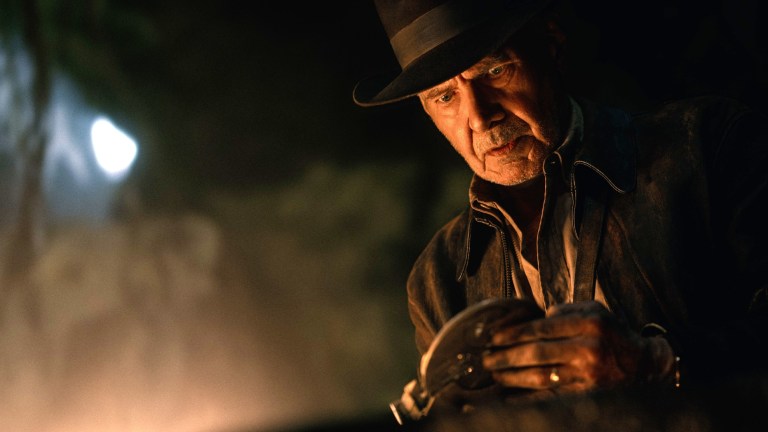Indiana Jones: The Antikythera, the Ark, and the Fact and Fiction Behind the Movies
Exploring the real life treasures, people, and history that inspired some of Indiana Jones’ adventures.

Along with Harrison Ford’s iconic character’s exploits cracking whips, globetrotting, wearing a fedora and leather jacket regardless of climate, and — we cannot emphasize this enough — punching Nazis, what turned audiences into voracious fan of Indiana Jones is how the treasure hunter would pursue artifacts that belong in a museum (preferably a museum in the area whence the artifact originated).
What we love about Indiana Jones is how the franchise tapped into real-world archaeological discoveries and mysterious artifacts. That tradition absolutely continues with Ford’s fifth and final outing as the adventurer in Indiana Jones and the Dial of Destiny.
Here are a few aspects of Indy’s pursuits of fortune and glory that are part fact and part fiction.
Adventuring Archaeologists
George Lucas’ creation is partially based on the sci-fi and adventure heroes from movie serials in the late 1930s/early 1940s, such as Buck Rogers and Zorro, but he is indirectly modeled after early 20th century archaeologists and explorers who gained rockstar status for their adventures. Roy Chapman Andrews of the American Museum of Natural History was a famous naturalist who struck a pose much like Indy, trekked across the Gobi Desert, and dug up fossilized dino eggs for the museum. Archaeologist and British Lt. Colonel Percy Fawcett claimed to have encountered strange animals, including a giant anaconda (it had to be snakes) before disappearing in 1925 while searching for the lost city of Z in the Brazilian jungles. National Geographic’s first archaeological grantee Hiram Bingham III brought Machu Picchu, “The Lost City of the Incas,” to the attention of Western cultures. Sir Leonard Woolley excavated the Sumerian royal tombs in the city of Ur — which inspired Agatha Christie’s Murder in Mesopotamia. And don’t get us started on King Tut’s curse…
Chachapoyan Fertility Idol
The golden idol Indy pursues in the character’s unforgettable introduction in Raiders of the Lost Ark belonged to the Chachapoyan tribe, which did exist. These “Warriors of the Clouds” lived in the dense Amazon forests of the Andes, in what is modern-day Peru, from the 9th century until they were wiped out by the Incas in the 15th century. However, the Hovitos tribe manipulated by rival archaeologist Belloq are fictional, and not descendants of the Chachapoyans.
The idol itself is directly inspired by a sculpture believed to be of the purifying and fertility Aztec goddess Tlazolteotl (on permanent display at the Dumbarton Oaks Museum in Washington, DC). Rather than gold, it’s carved out of a bluish-green, of 19th century Mexican origins, but may be an “idealized conception of Aztec artistic expression.”
Ark of the Covenant
First appearing in the Book of Exodus, the Ark’s assembly instructions — which are more detailed than most IKEA furniture — were dictated by God to Moses, and intended to hold the Ten Commandments tablets, as well as manna, and the rod of Aaron (as in Moses’ brother, not this article’s author). Within the Bible, it was last seen by King Hezekiah of Judah around the 7th century BCE.
There are countless stories of the Ark being moved around, and ending up in various locations such as Ethiopia, Rome, Ireland, and Tanis, Egypt where the Nazis were searching for it in Raiders. Whether or not it actually existed remains a debate, but its existence seems plausible. One historian, Tudor Parfitt, theorized in 2008 the Lemba people of Zimbabwe obtained it and used it as a superweapon (which makes it all the more fun to think of this “Voice of God” melting Nazi faces — which is even better than punching them).
Sankara Stones
In Indiana Jones and the Temple of Doom, the Sankara Stones were given to the priest Sankara atop Mount Kalisa to battle evil. These resemble lingam stones, or representations of the deity Shiva in Hindu faith, and Mount Kailash is indeed believed to be the abode of that god (and has spiritual significance to other faiths, as well).
As far as Mola Ram’s Thuggee Cult, they might have truly existed. Said to be a criminal organization, from where we get the word “thug,” they may have also worshiped the goddess Kali, though postcolonial scholars question earlier historians.
The Holy Grail
The Grail in Last Crusade is said to be the cup Jesus Christ used at the Last Supper, and into which some of his blood spilled during crucifixion. It first appeared in literature in the 12th century, and came to be connected with Arthurian legends and the real-life, and mysterious, Knights Templar who — like the fictional Brotherhood of the Cruciform Sword — served as protectors of the grail.
Although likely falling under the category of pseudo-history, enough people have embarked on quests for the Grail, and countless local legends exist in various countries about it hiding there, to make its existence, like the Ark, seem conceivable. A chapel in Chwarszczany, Western Poland, with its recently discovered hidden tunnels, seems like a pretty strong contender as its resting place. And yes, the facepunch-worthy Nazis did have an interest in finding the grail, specifically occultist Heinrich Himmler and medievalist Otto Rahn.
Crystal Skulls
Say what you will about Kingdom of the Crystal Skull (2008), the film’s MacGuffins are real, sort of. There are 13 said to exist around the world, including at the British Museum and Smithsonian Institution, and believers say they originated with Mesoamerican civilizations tens of thousands of years ago. There are stories connecting them to the Aztecs, Atlantis, and ancient aliens, and that they can enhance psychic abilities or have healing properties. But science doesn’t back this up: the ones examined by electron microscope were crafted as recently as the late mid-to-late 1800s, reports National Geographic. Still, there remains lore and fascination with the skulls. Ghostbuster, and paranormal enthusiast, Dan Aykroyd pays homage to them with his Crystal Head Vodka brand.
Interestingly, the most famous crystal skull, the Mitchell-Hedges skull, was at the center of a 2012 lawsuit, which also entangled Lucasfilm. Explorer Frederick “F.A” Mitchell-Hedges and his young daughter Anna claimed to have unearthed their “Skull of Doom” on New Years Day 1924 in Belize (even though it was later revealed he purchased it as a Sotheby’s auction in 1943). Still, the story of the skull’s provenance was enough to warrant Dr. Jaime Awe, director of the Institute of Archeology of Belize, to sue for the return of the skull to the country from the Mitchell-Hedges family. Additionally, because Kingdom of the Crystal Skull’s artifact very loosely resembles it, damages were sought against Lucasfilm, The Walt Disney Company, and Paramount Pictures for profiting off the likeness of the skull without permission.
Dial of Destiny
Though you must see the latest Indiana Jones installment to know precisely what the titular Dial of Destiny is, there are a few artifacts connected to the term “Destiny.”
The real-life Stone of Destiny is a symbol of Scotland, with legends placing its origins in Biblical times, and was used for centuries in the coronation of Scottish kings before it was nicked by King Edward I of England in the 13th century. It was stolen from Westminster Abbey by Scottish students in 1950, and returned to England before it was ultimately given back to the Scots in 1996. Though it returned to Westminster, briefly, for the coronation of King Charles III.
Meanwhile, the Spear of Destiny — which has a cameo of sorts in Dial of Destiny — was the weapon used by a Roman centurion to pierce the body of Jesus after his crucifixion. It pops up in historical records in the 6th century, and there are a few claims that the relics of the “Holy Lance” exist in Rome, Vienna, and elsewhere. Indy actually previously pursued it in the 1995 Dark Horse comic Indiana Jones and the Spear of Destiny.
But the Dial of Destiny in the film is inspired by the Antikythera Mechanism, aka “The First Computer” used by the ancient Greeks to calculate astronomical paths. Discovered in 1901 in a shipwreck, after 2,000 years under the sea, the bronze gear of the mechanism looks like a “dial,” and it has figured into Erich von Däniken’s ancient aliens theories. In the movie, the Nazi scientist Voller, played by Mads Mikkelson, has an interest in it. Perhaps he views it as a way to harness the power of the stars, or turn back time so the bad guys could win World War II — and avoid well-deserved face punches.
Indiana Jones and the Dial of Destiny is in theaters now.
